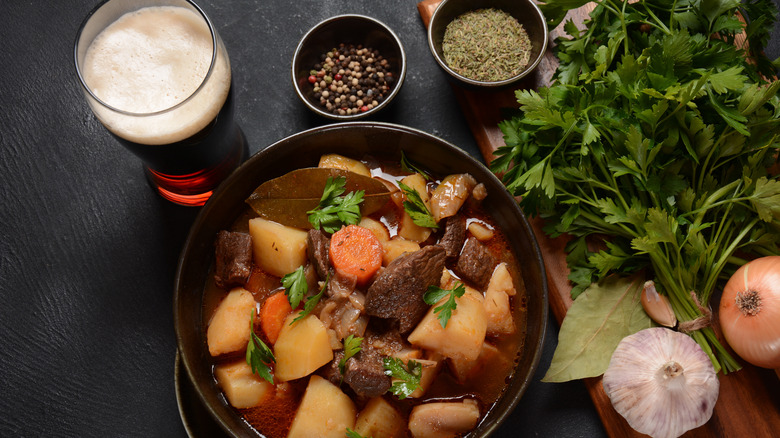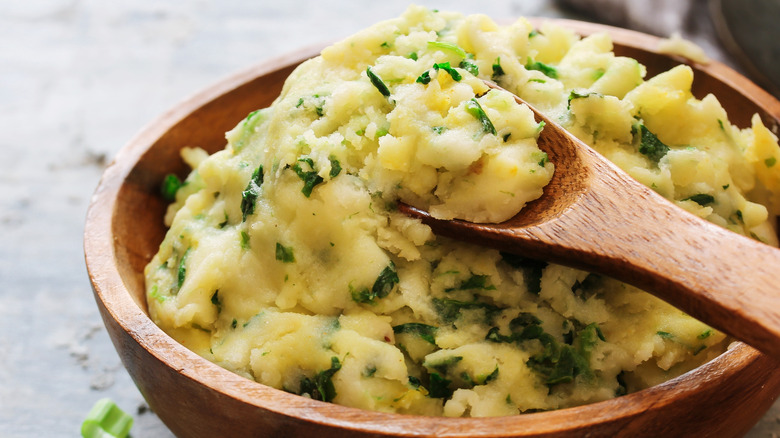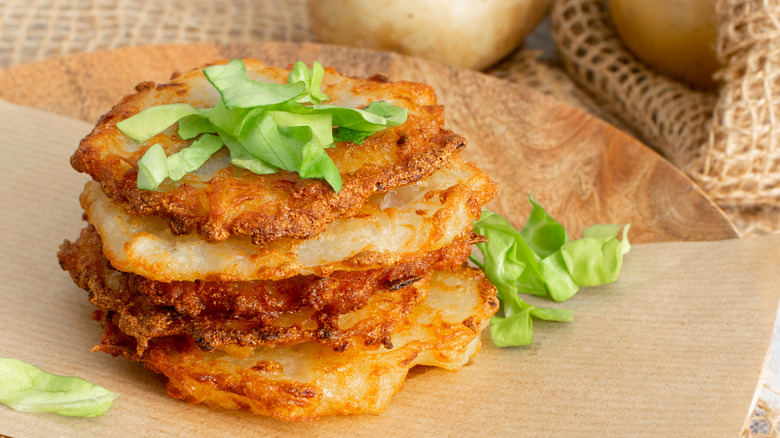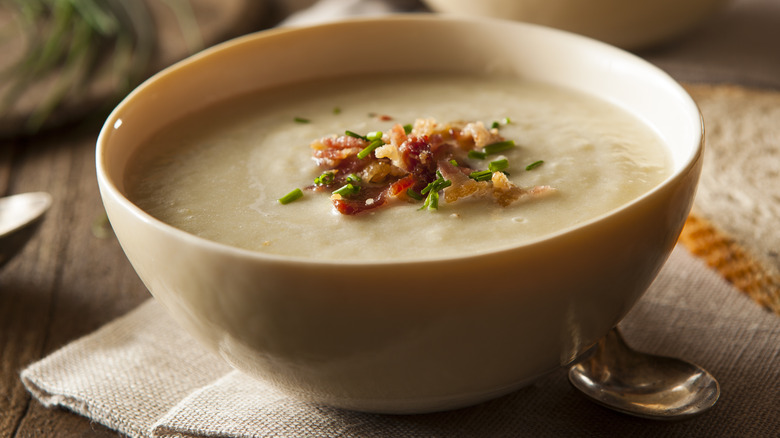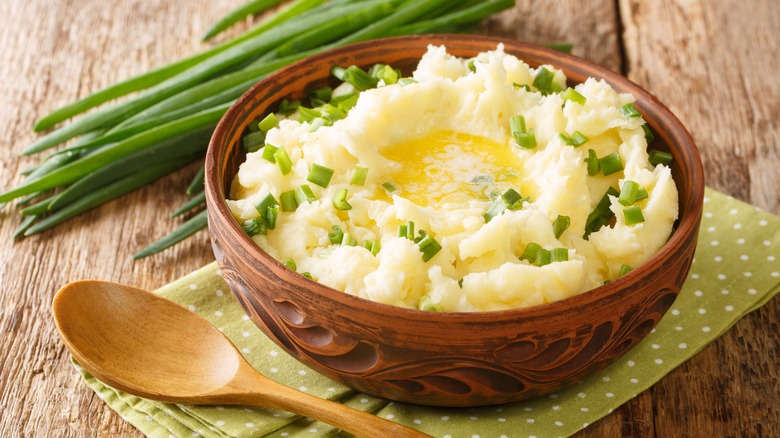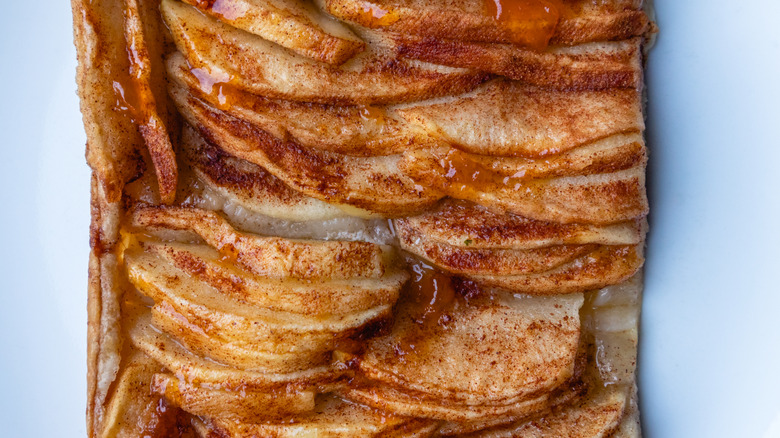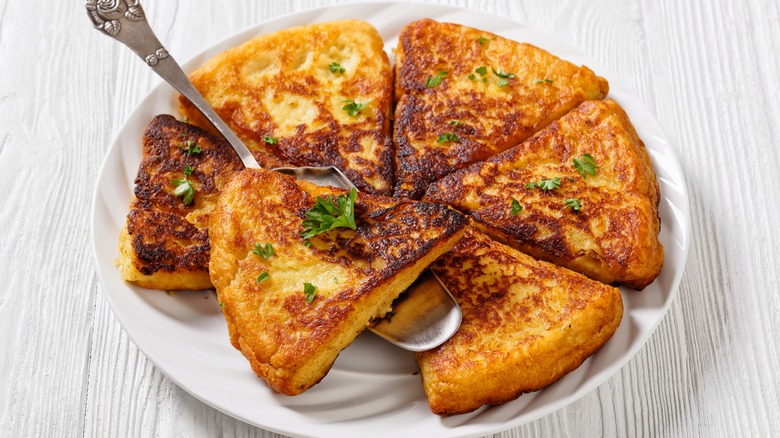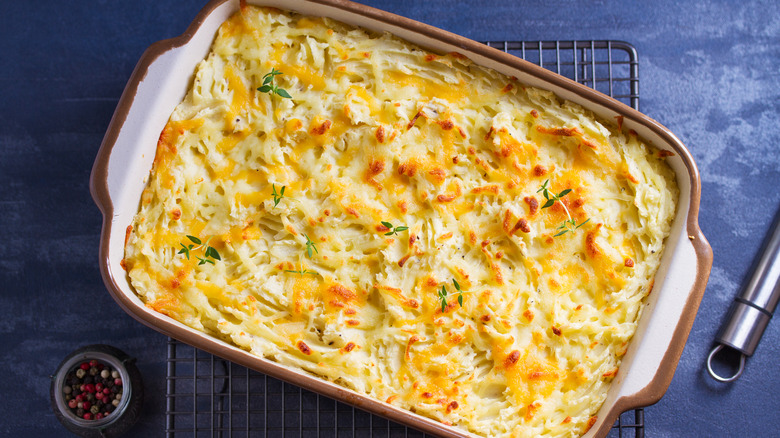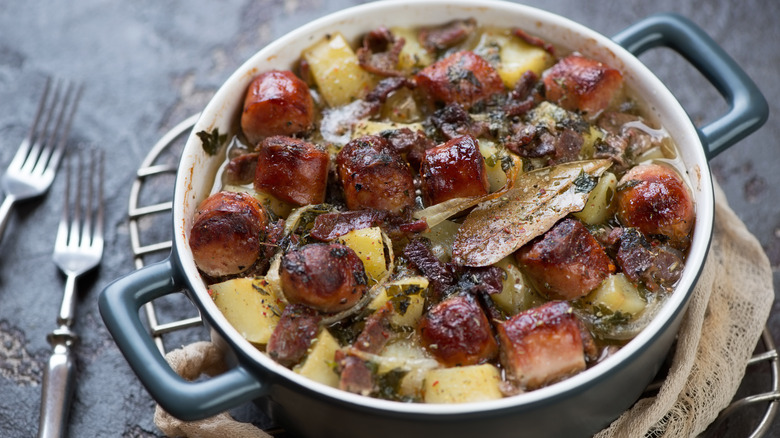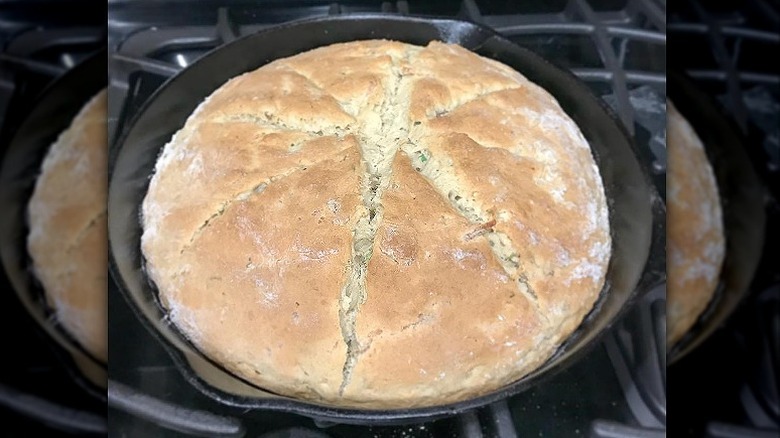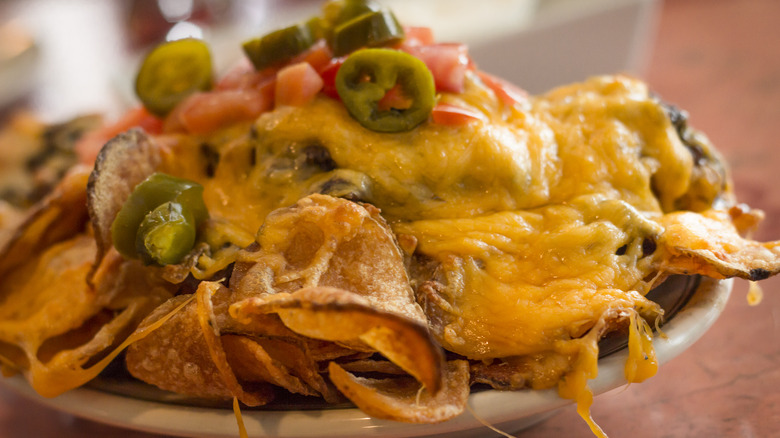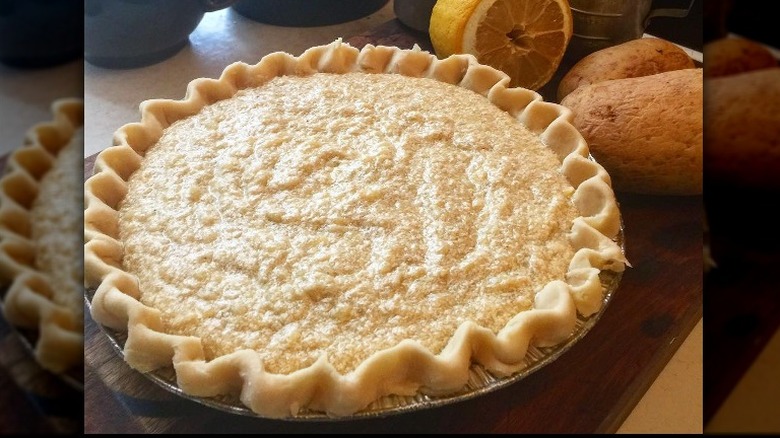11 Irish Potato Dishes You'll Wish You Knew About Sooner
No matter how hard we try, it's impossible to separate certain ingredients from their respective cuisines. For example, Italian cuisine would be nothing without pasta. Chinese food would be naked without rice. And Indian dishes would suffer if the curry was missing. When it comes to Irish food, potatoes are as essential to the cuisine as a pint of Guinness is to celebrating Saint Patrick's Day.
The Emerald Isle's love affair with tubers goes back to the 16th century. At that time, the English invaded Ireland, forcing the native Irish to relocate to the country's rocky coastal areas. Besides being inexpensive and nutritious, potatoes were one of the few foods hearty enough to grow in the poor-quality soil. As a result, potatoes quickly became a staple crop. With that in mind, it's no wonder that so many of Ireland's dishes center around potatoes. No doubt you've heard of shepherd's pie and bangers and mash, but there's a lot more potato goodness to discover. In this article, we're introducing you to 11 Irish potato dishes you'll wish you knew about sooner. Along with a brief introduction of each dish, we give you insider preparation tips so you can experiment at home.
Colcannon is the king of Irish potato dishes
Taking its name from the Gaelic word for white-headed cabbage, cál ceannann, colcannon is one of Ireland's most famous and most beloved potato dishes. The traditional colcannon recipe calls for two main ingredients: starchy mashed potatoes (russet, Maris Piper, or Melody work well) and sautéed greens (either cabbage or kale). These ingredients are combined with salt, butter (lots of it), green onions, and milk to create a creamy mash that's filling and easy to assemble. Not only is it delicious, but it's an easy way to sneak some extra veggies into your diet.
While simple, this dish tells you everything you need to know about Irish cooking. To begin with, the ingredients are inexpensive, hearty, and readily available — three features that were essential during the country's rocky past. What's more, colcannon is flexible. Although cabbage and kale are the most common greens, you can easily substitute whichever leafy greens you have on hand. For example, broccoli leaves, watercress, or chard are perfectly at home in colcannon. Once prepared, colcannon is served alongside other Irish favorites such as boiled ham, corned beef, or Irish stew.
Swap out regular hashbrowns for boxty
While we're sure that you've eaten your fair share of hashbrowns, we're willing to bet that you've never tried boxty, the Irish version of this beloved brunch staple. But even though boxty resembles hashbrowns, it feels almost wrong to compare the two. That's because standard hashbrowns are made using only grated potatoes. Boxty, on the other hand, is made with a combination of grated and mashed potatoes, something that makes them extra crispy on the outside and delightfully soft on the inside.
To make the perfect boxty, start with starchy potatoes like russets or Idahos. Compared to waxier varieties, starchy potatoes absorb liquids better and have a crispier texture when fried. Mash and chill half of the potatoes. Grate the other half using a grater or mandolin slicer. Combine the two types of potatoes with a flour mixture (flour, baking soda, and salt), then add buttermilk to bind everything together. Fry individual patties in a heavy pan over medium-high heat until you obtain a golden brown color on both sides. Serve them hot with a dollop of sour cream, a fried egg, or smoked salmon. For the full effect, do as the Irish do and make boxty on St. Brigid's Day (February 1st). Saint Brigid is the patron saint of dairy, so frying up these buttermilk-heavy potato pancakes is the perfect way to celebrate.
Warm up with Irish potato and leek soup
Like colcannon, traditional Irish potato and leek soup is a simple dish that uses easy-to-access ingredients as its base. In addition to starchy potatoes and fresh leeks, you'll need just a few simple ingredients to make this creamy belly-warming soup. The simplest recipes call for butter, chicken stock, and a healthy serving of salt and pepper. More involved recipes include garlic, onion, and heavy cream.
Regardless of the recipe you choose, know that this soup couldn't be simpler to make. That's why it's one of our favorite Saint Patrick's Day recipes. Start by combining cooked leeks with diced potatoes in the chicken broth, then bring to a boil. Simmer for 10 to 15 minutes, then use an immersion blender to purée the soup to creamy perfection. Melt a couple of tablespoons of butter into the finished product and season to taste with salt and pepper. Top with fresh chives, bacon crumbles, sour cream, or a combination of all three. If you're really short on time, toss all of the ingredients into an Instant Pot and you'll have a finished product within 15 minutes. Alternatively, you can prepare the soup ahead of time and freeze it for up to three months before serving.
Put a new spin on mashed potatoes with champ
No one would blame you for mixing up colcannon and champ. After all, both dishes are essentially just mashed potatoes mixed with greens. Moreover, they're both commonly served alongside sausages or corned beef. However, despite their similarities, colcannon and champ do have some noticeable differences. In terms of ingredients, colcannon contains cabbage or kale, while champ uses green onions or stinging nettles. Furthermore, champ usually contains a raw egg blended into the mash. Apart from the differences in ingredients, colcannon originated in Southern Ireland, whereas champ is a decidedly Northern Irish dish.
Making champ couldn't be easier. We recommend using starchy potatoes, like russets, as they'll lead to a fluffier, creamier finished product. Peel the potatoes, then boil for 20 minutes or until soft. Drain and mash the potatoes, then incorporate milk, chopped green onion (or stinging nettle), salt, and Irish butter. Season with pepper, then serve with a pat of butter on top. If incorporating a raw egg, crack the egg into the mash right before serving as well.
Potatoes and apples pair beautifully in this Irish take on pudding
Most of us tend to think of potatoes as a savory ingredient, but it turns out they're a delicious addition to sweet dishes as well. In particular, the Irish have found a way to incorporate potatoes into steamed apple pudding. This winter dessert combines farmhouse cider, milk, cooking apples, mashed potatoes, sugar, flour, butter, lemon, and cloves. Nutmeg and cinnamon can also be added for some additional spice.
While the ingredients might seem heavy, this pudding is easy to digest. Plus, compared to other steamed puddings that contain extra fat, this version is fairly light. To make it, mash the potatoes and mix with flour and milk until a dough forms. Line a pie plate with the dough, reserving some for the lid. The filling consists of sugared sliced apples, cloves, lemon juice, and cider. Cover the filling with the remaining dough and seal the edges. Next, cover everything with foil and steam in a large saucepan or steamer for two and a half hours. When finished, serve with custard.
Turn potatoes into bread with this potato farl recipe
Although potato pancakes are often associated with Eastern European cuisine, many countries have their own version of the beloved side dish. For instance, the Swedes eat potatisplättar, a thin pancake made with shredded boiled potatoes, wheat flour, milk, and egg. Halfway around the world, Koreans chow down on gamja-jeon, pan-fried potato pancakes mixed with onion, chili, or perilla leaf. Given the popularity of similar fishes, it'll come as no surprise that the Irish have their own version of potato cakes.
The Irish version, which is also referred to as a potato scone or a potato farl, contains four simple ingredients: mashed potatoes (freshly made or leftover), flour, melted butter, and salt. Like many Irish recipes, potato farls are easy to whip up. Simply incorporate the flour, butter, and salt into the potatoes after mashing them. Mix until a dough forms. Knead the dough on a floured surface and use a rolling pin to make a circular dough about ¼ of an inch thick. Cut the dough into four sections. Cook in a floured skillet until golden brown, then serve with a sprinkling of salt. Pair them with bacon and eggs at breakfast or with salmon or pork chops at lunch.
Cottage pie is the ultimate comfort food
Chances are you've tasted shepherd's pie before. In case you're not familiar, it's a hearty dish made with ground lamb cooked in gravy and a vegetable medley of onions, carrots, peas, and celery. These ingredients are then covered with a creamy mashed potato crust (some recipes call for a mashed potato base as well). Cottage pie is pretty much the same thing, except that it's made with ground beef instead of lamb.
Although their ingredients differ, both savory casseroles illustrate the country's history. Namely, they're the result of Ireland's poor past. Unwilling to waste even a scrap of food, Irish home chefs would repropose leftover meat to create the dish. If you're wondering about the name, much of Ireland's working class used to live in cottages. Because it was traditionally considered a peasant's dish, the name pays homage to Ireland's poorest citizens by referencing their traditional dwellings. Shepard's pie and cottage pie get used interchangeably, but make no mistake about it — shepherd's pie contains lamb, while cottage pie contains beef.
If you want to make this traditional dish, start by cooking ground beef with dried spices (parsley, thyme, rosemary, salt, and pepper), garlic, Worcestershire sauce, flour, and tomato paste. Incorporate beef broth and frozen mixed vegetables. Separately, boil potatoes until tender, then combine with butter and cream. Pour the meat mixture into a casserole dish, then top with the mashed potatoes. Bake in a 400-degree Fahrenheit oven until the potatoes turn golden brown.
Transform leftovers into Dublin coddle
Like many traditional Irish dishes, Dublin coddle isn't exactly what you'd call refined. Rather, it's a hearty one-pot stew made with leftover meat (usually sausage and bacon), potatoes, and onions. That said, there isn't just one authentic version of the dish. Ever since the dish appeared in the mid-1700s, families have been adapting the recipe according to what they have on hand. That meant adding other types of meat, incorporating carrots or other root vegetables, or mixing in some barley.
While the economic reasons are no longer the main driver behind Dublin coddle's popularity, it continues to be a favorite winter dish both in Ireland and abroad. If you want to try it out for yourself, you'll need pork sausages, bacon, waxy potatoes (like New potatoes or Red Bliss), onions, garlic, chicken broth, and spices (salt, pepper, and parsley). Brown the meat, cook the onions, and quarter the potatoes. Once all of the ingredients are ready, create layers in a Dutch oven. Start with potatoes, add some onions and bacon on top, then repeat. Top everything with the sausages and cover with chicken broth. Cook for two hours in a 300-degree Fahrenheit oven. Serve with some Irish soda bread and a fresh pint of Guinness for the full Irish pub experience.
Potato bread used up potatoes in a unique way
If you search for Irish potato bread, you'll likely find all kinds of recipes for potato farls. That's fine, but what many people may not realize is that there's a whole other type of Irish potato bread out there. Referred to simply as Irish potato bread, this savory quick bread is one Irish potato dish you wish you knew about sooner.
Like boxty, Irish potato bread is made with a combination of mashed and grated potatoes. The potatoes are combined with eggs, garlic powder, milk, and vegetable oil. Adding Parmesan cheese is optional, but why wouldn't you take the opportunity to add more cheese to your diet? In a separate bowl, mix flour, baking powder, and salt. Add the dry ingredients to the potato mixture and stir until a dough forms. Knead the dough into a ball, then place it into an oiled cast iron skillet. Make an X on the top of the dough, then bake for 45 minutes at 375 degrees Fahrenheit. Use it to sop up the gravy from a Dublin coddle or an Irish stew.
Irish pub potato nachos will surprise your taste buds
Don't get us wrong, we love nachos just as much as everyone else. But sometimes they can feel a bit uninspired. Thankfully, there are plenty of ways to liven up boring nachos. For instance, you could swap beef for chicken or fresh shrimp. Or you could try authentic queso Oaxaca instead of your typical four-cheese blend.
But neither of these substitutions gets to the root of the problem — the chips. Instead of using plain old tortilla chips, use thinly sliced potatoes. Not only will they give your nachos a new lease on life, but you'll also discover the beauty behind Irish pub nachos. To prep the potatoes for serving, rinse them and season them with garlic powder, Italian seasoning, salt, and pepper. Bake the slices in a 390-degree Fahrenheit oven for 40 minutes, flipping the potatoes halfway through. After the potatoes have reached crispy perfection, it's time to get creative with toppings. We're big fans of classic ingredients like cheese, beans, chili, and guacamole, but feel free to experiment with different flavors.
Hide the taste of potatoes in an Irish potato pie
When it comes to Irish potato dishes you'll wish you knew about sooner, sweet recipes take the cake (pun intended). It's not that thick stews and savory bread aren't amazing, it's just that using potatoes to whip up sweet treats is such a novel idea. One of our favorite potato desserts is Irish potato pie, a smooth treat similar to custard. The creaminess alone is enough to make this dessert a winner, but the complete lack of potato flavor is what's truly magnificent.
This tasty dessert uses simple ingredients. All you need for the filling are mashed potatoes, eggs, cream, sugar, and a couple of spices (salt, vanilla extract, and nutmeg). Combine the eggs with cream, potatoes, sugar, and salt. You can also add a tablespoon of Irish whiskey or brandy, but this is optional. Pour the ingredients into a homemade or store-bought pie crust, then cover the edges with aluminum foil. Bake for 40 minutes in a 350-degree Fahrenheit oven. Remove the foil and bake for another 15 minutes. Cool and decorate with sliced almonds and nutmeg. Serve at room temperature.
Static Media owns and operates Tasting Table and Mashed.
